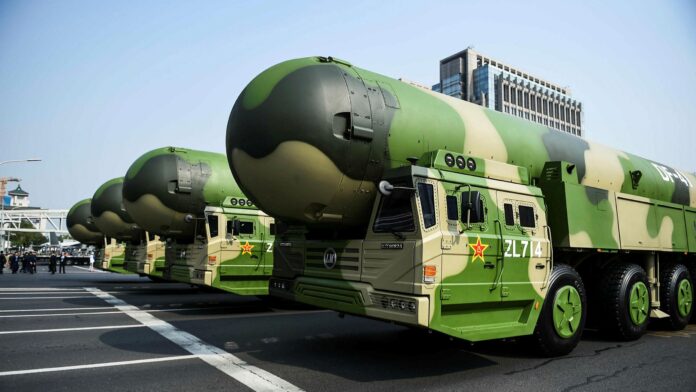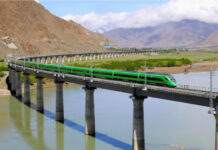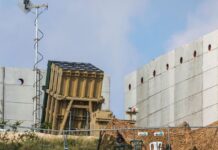The US security establishment is increasingly making a realistic assessment regarding the Chinese nuclear arsenal in particular and the military prowess of China in general. The Pentagon Report is gradually informing the Congress and through it to the world the emerging and threatening military design of China. Although the 2021 Pentagon Report has stunned the world by telling the annual increase in the number of nuclear warheads, yet in other spheres relating to nuclear weapons, the Chinese move is consistently battle-oriented. The diversity of delivery vehicles leaves the security community assess the missions China may undertake in the near future and in the long-term. The assessment is made from the American perspective, yet it gives the Indian security establishment an opportunity to revisit its own understanding and strategy in the new strategic environment.
By Rajiv Nayan
On 3 November 2021, the United States Department of Defense (US DOD) released its annual report to the Congress titled “Military and Security Developments Involving the People’s Republic of China”, also called the Pentagon Report. While the standard chapters such as “Understanding China’s Strategy” and “Resources and Technology for Force Modernization” have featured in the recent years with updated data, the 2021 report covers three special topics—“The PRC’s Effective Control Concept and PLA Escalation Management Views”, “PRC’s Evaluation of the 13th Five Year Plan” and “PRC-India Border Standoff”.
Of all the elements, the news of the rapid increase in the nuclear forces of China, as revealed in the report, seems to have surprised the media and the strategic community. The report covers different aspects of the Chinese nuclear forces. While some of the data collated and analyses have already been provided in the earlier reports, the new information given in the 2021 report has led to discussions not only in the US Congress but also all over the world, especially in countries which could be affected by the aggressive Chinese behaviour.
Increase in the Stockpile
The information given in the 2021 Pentagon Report about China increasing its nuclear warheads has grabbed the attention of the media, however, the report also has information on other elements of the Chinese nuclear forces. China was the first nuclear-weapon country to keep its nuclear weapons stockpile a secret. Before that, all the nuclear-weapon countries used to announce the size of their nuclear weapons stockpile publically or officially, though the issue of verification always dogged the claims and this would often result in accusation and counter-accusation. After China’s nuclearisation, no new nuclear weapon country has made its weapon stockpile public. Israel has not even declared its nuclearisation, but it is widely acknowledged as a nuclear-weapon country.
The 2021 report mentions that in the next six years, i.e., by 2027, China may have “up to 700 deliverable nuclear warheads”, and that the number is likely to increase to “at least 1,000 warheads by 2030”.2 The report states that this is the result of China’s rapid nuclear weapons development policy, effected in turn by the Chinese investment in its nuclear infrastructure. In general, it may have talked about the development of general nuclear infrastructure, yet it has made a special mention of the role of plutonium reprocessing for its nuclear weapon growth. In this regard, it has talked about the fast breeder reactor and reprocessing facilities. Interestingly, the 2021 report radically departs from its assessment made in its 2020 report, where the US DOD had predicted that China, which had the nuclear weapons stockpile in “low-200s”, may “at least double” it by 2030.
The report has used the phrase “up to 700”, thus indicating that the highest number could not be more than 700, and the use of the phrase “at least 1000” means that it expects greater expansion after 2027. However, the 2020 report, too, had predicted at least doubling of the low 200 arsenals means staying around or below 500 nuclear warheads. So, in the last one year, the US intelligence community believes that China has given priority to increasing the stockpile of its nuclear weapons. As mentioned earlier, the authoritative official data for the Chinese nuclear weapons stockpile is not available, therefore it is a matter of speculation.
The Pentagon reports give an official American government estimate of the Chinese nuclear weapons stockpile. Some Non-Governmental Organisations (NGOs) are also predicting the nuclear stockpile of China and of other nuclear-weapon countries, including those which had not disclosed their nuclear weapons stockpile publically or officially. The Federation of American Scientists (FAS) and SIPRI among others have been regularly publishing their estimates of the nuclear stockpile of China and of other nuclear-weapon countries.
In December 2020, Hans M. Kristensen and Matt Korda from the Federation of American Scientists in their report predicted that China had approximately 350 nuclear warheads. The authors underlined in their report that their speculation of the Chinese nuclear weapons is higher than that of the 2020 Pentagon report. SIPRI, in its January 2021 report, also predicted the same number—350 nuclear warheads. It underscored that in 2020, China had only 320 warheads. Other American and European think tanks seem to have copied the number given in the report of the FAS.
More than a decade ago, a former Pentagon official, Phillip Karber had estimated that China possessed about 3,000 nuclear warheads. However, neither the Chinese government nor the strategic community has endorsed this number. Is the US policy-making community moving towards Karber’s number gradually? The US security establishment, in the post-Cold War period, started realising the mischief potential of China. It was found to be involved in the proliferation network, which was benefiting China as well. But the American establishment sanitized any report on China quite drastically.
Silos
Like the drastic increase in the nuclear stockpile in comparison to the 2020 report, the 2021 report also covered in detail the silo-based nuclear capable missiles. The silo-based missiles had figured in the reports already in the public domain before and after the publication of 2020 report. Quite significantly, the FAS had brought out a report earlier in 2019, which mentioned that “satellite photos acquired from Digital Globe (Maxar) show that the People’s Liberation Army Rocket Force (PLARF) is building what appears to be a new type of missile silo in the missile training area near Jilantai, possibly for use by a new ICBM”. In recent months, Western media has been reporting the operation of the Chinese nuclear weapons silos. The reports state that over 250 new long-range missile silos exist or are being constructed.
These silos exist at three places—at Yumen and Hami in north-western China and at Hanggin Banner in Inner Mongolia. The James Martin Center for Nonproliferation Studies in California had revealed the existence of a site in June 20218, FAS did so in July 2021 and Chinese Aerospace Studies Institute, Air University—all three from the US in August 2021.10 Interestingly, in 2021, too, the information on the silos in the public domain has come through Non-Governmental Organisations, which ostensibly procured the data from commercial satellites.
However, a section of the Western strategic community, including Gareth Evans, the former Australian Foreign Minister, and the head of the Asia-Pacific Leadership Network, is still bailing out China, and maintains that “some of the fears may be misplaced”. Gareth Evans thinks that silos could be useful for China’s strategy of playing Shell Game of 1970s, in which the enemy is lured to bomb empty silos and the missiles are moved from one silo to another. Though this section accepts the existence of silos, it propounds the thesis that each silo may not be filled with a nuclear-tipped missile. Jeffrey Lewis, a highly respectable name on the Chinese nuclear weapons, belonging to the Middlebury Institute that facilitated the first leak, maintains that 120 silos may have only 12, not 120, nuclear-tipped missiles.
Updation
The 2021 Pentagon report understandably also provides an update on the developments given in its 2020 report. While the 2020 Pentagon report reported the number, the 2021 version added either the number or a new dimension or both. For instance, regarding ICBMs, like the previous report, the 2021 report also mentions China possessing about 100 missiles; it also adds that China is planning to double ICBMs. The 2021 report also informs about launching of “more than 250 ballistic missiles for testing and training”, as well as firing of anti-ship ballistic missiles against a moving target. In 2019, China had paraded its DF-17 Hypersonic Glide Vehicle. The 2021 Pentagon report tells that the DF-17 has been deployed, and thus, becomes the first operational hypersonic weapon in the world.
Similarly, as per the 2020 report, China had four operational Jin-class Ship Submarine Ballistic Nuclear (SSBN), while the 2021 report indicates six operational Jin-class SSBNs. The 2021 report also informs that China has nine nuclear attack submarines, whereas the 2020 report mentioned only six such submarines. As for Air Force, the Pentagon reports have given information about the H-6-N bomber, its refuelling capabilities and the increase in the nuclear capable air-launched ballistic missiles. However, the current 2021 version moves a step forward and informs that the bomber division may start “developing tactics and procedures to conduct the PLAAF nuclear mission”.
Conclusion
The appearance of this information has shocked and puzzled the world. Some are questioning the timing of the appearance of the information. A number of exercises are taking place discussing strategic and security implications of the feared expansion of the Chinese nuclear stockpile. The strategic and security communities of different countries are undertaking exercises from their own perspectives. The 2021 Pentagon Report continued the earlier exercise of assigning different missiles for different missions. If ICBMs are the jewel of the crown targeting the US, other medium and intermediate range missiles are also considered valuable in the emerging Asian battlefield in the American thinking expressed in the Pentagon report.
The ongoing shift in the American thinking vis-à-vis China is taking place. The American grand strategy was to make China an important stakeholder of the global non-proliferation system so that the world has strategic stability. However, as American industry continued to do business with China, the sanitisation of the reports helped it in overlooking Chinese proliferation, and avoid imposing comprehensive sanctions on it, though occasionally, the US did impose institution-specific curbs on China. In recent years, it seems, the American establishment has been disillusioned with China, and has begun to maintaining a tough posture and policy. The leaks could be a step towards projecting a realistic picture of China. For India, the increase in the number of intermediate, medium and short range missiles in China is a real matter of concern. The changing Chinese nuclear policy may turn these missiles better weapons to target the Indian facilities.
This article first appeared in www.idsa.in and it belongs to them.








